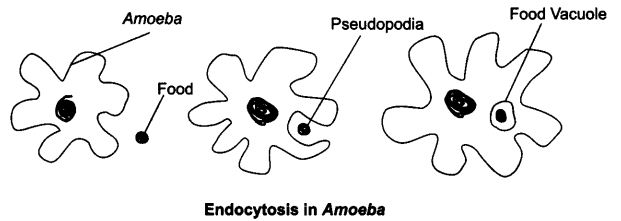Solutions For All Chapters Science Class 9
Questions From NCERT Textbook
Question 1. Make a comparison and write down ways in which plant cells are also different from animal cells.
Answer:
Question 2. How is prokaryotic cell different from a eukaryotic cell?
Answer: Prokaryotic cell is generally smaller in size (1-10 pm), nuclear region is poorly defined, the cell organelles are not membrane-bound and has a single chromosome.
Eukaryotic cell is generally larger in size (5-100 pm), nuclear region is well defined with nuclear membrane. Membrane-bound cell organelles are present and has more than one chromosome.
Question 3. What would happen if the plasma membrane ruptures or breaks down?
Answer: If plasma membrane ruptures or breaks down then molecules of some substances will freely move in and out.
Question 4. What would happen to the life of a cell if there was no Golgi apparatus?
Answer: Golgi apparatus has the function of storage, modification and packaging of the products in vesicles. If there were no Golgi bodies, packaging and dispatching of materials synthesised by the cell will be stocked.
Question 5. Which organelle is known as the powerhouse of the cell? Why?
Answer: Mitochondria is known as powerhouse of the cell because it releases the energy required for different activities of life.
Question 6. Where do the lipids and proteins constituting the cell membrane get synthesised?
Answer: Lipids and proteins are synthesised in ER [Endoplasmic Reticulum].
Question 7. How does Amoeba obtain it’s food?
Answer: Amoeba take it’s food by the cell membrane which forms the food vacuole.
Question 8. What is osmosis?
Answer: Osmosis is the process of movement of water molecule from a region of higher water concentration through a semi-permeable membrane to a region of lower water concentration.
Question 9. Carry out the following osmosis experiment:
Take four peeled potato halves and scoop each one out to make potato cups, one of these potato cups should be made from a boiled potato. Put each potato cup in a trough containing water.
Now,
(a) Keep cup A empty
(b) Put one teaspoon sugar in cup B
(c) Put one teaspoon salt in cup C
(d) Put one teaspoon sugar in the boiled potato cup D
Keep these for two hours. Then observe the four potato cups and answer the following:
(i) Explain why water gathers in the hollowed portion of B and C.
(ii) Why is potato A necessary for this experiment?
(iii) Explain why water does not gather in the hollowed out portions of A and D.
Answer:
(i) Water gathers in B and C because in both the situations there is difference in the concentration of water in the trough and water in the cup of Potato. Hence, osmosis takes place as the potato cells act as a semi-permeable membrane.
(ii) Potato A is necessary for this experiment for comparison, it acts as a control.
(iii) Water does not gather in the hollowed out portions of A and D. As cup of A does not have change in the concentration for water to flow. For osmosis to occur one of the concentration should be higher than the other.
In cup D, the cells are dead and hence the semi-permeable membrane does not exists for the flow of water and no osmosis takes place.
10. Which type of cell division is required for the growth and repair of the body, and which type is involved in the formation of gametes?
Solution:
There are two ways in which a cell divides:
- Mitosis
- Meiosis
Mitosis is the type of cell division that is involved in the growth and repair of the body, whereas meiosis is a type of cell division which results in the formation of gametes.
NCERT Textbook for Class 9 Science – Page 51
Question 1. Who discovered cells, and how?
Answer: Robert Hooke discovered cells in 1665 while examining a thin slice of cork through a self-designed microscope. He saw that the cork resembled the structure of a honey comb consisting of many little compartments. These small boxes are called cells.
Question 2. Why the cell is called the structural and functional unit of life?
Answer: A cell is capable of independently carrying out all necessary activities of life. So, they are called basic or functional unit of life.
Class 9 Science NCERT Textbook – Page 53
Question 1. How do substances like CO2 and water move in and out of the cell? Discuss.
Answer: CO2 moves by diffusion and H2O move by osmosis through cell membrane.
Question 2. Why is the plasma membrane called a selectively permeable membrane?
Answer: It is called selectively permeable membrane because it allows the entry and exit of some substances, not all.
Class 9 Science NCERT Textbook – Page 55
Question 1. Fill in the gaps in the following table illustrating differences between prokaryotic and eukaryotic cells.
Answer:
NCERT Textbook for Class 9 Science – Page 57
Question 1. Can you name the two organelles we have studied that contain their own genetic material?
Answer: The two organelles which have their own genetic material are:
1. Mitochondria 2. Plastids
Question 2. If the organisation of a cell is destroyed due to some physical or chemical influence, what will happen?
Answer: The cell will not be able to revive and lysosomes will digest it.
Question 3. Why are lysosomes known as suicide hags?
Answer: When the cell gets damaged, lysosomes may burst, and the enzymes digest their own cell. Therefore lysosomes are known as suicide bags.
Question 4. Where are proteins synthesised inside the cell?
Answer: The proteins are synthesised in the ribosomes that are also known as protein factories.





Leave a Reply